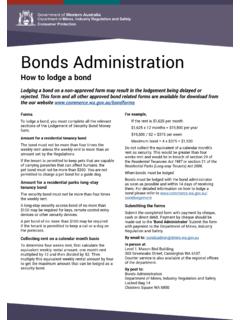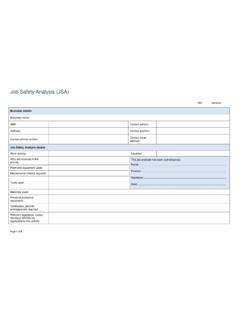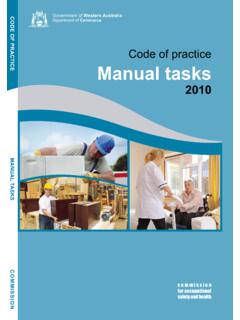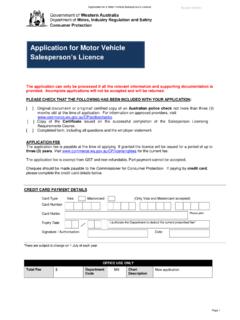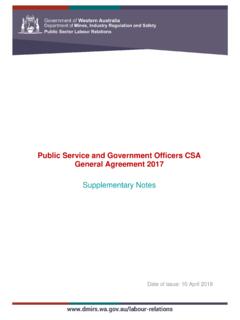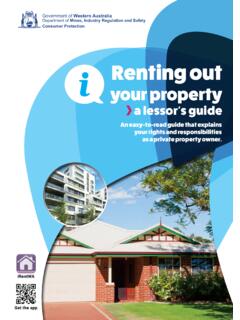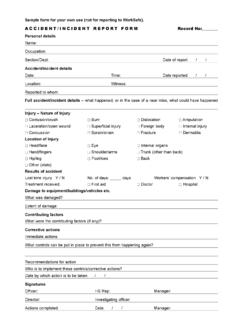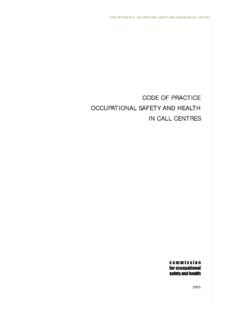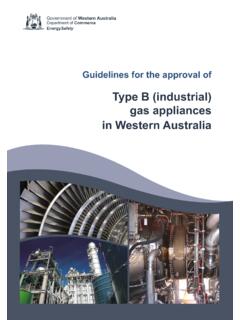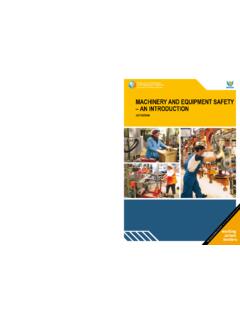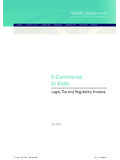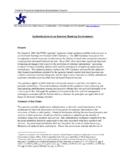Transcription of OSH in the restaurant industry - Department of Commerce
1 Mason Bird Building, Level 1, 303 Sevenoaks St (cnr Grose Ave), Cannington WA 6107 Locked Bag 14, Cloisters Square, PERTH WA 6850 Telephone:1300 307877 Email: Internet: OSH in the restaurant industry Introduction Since 2010 WorkSafe has conducted focused inspection campaigns in both take away food and restaurant industries. During these campaigns inspectors saw instances where workers had suffered serious burns while performing everyday tasks such as, cleaning chicken rotisserie trays, transferring hot oil and removing food from a microwave.
2 Scalds and burns can occur anywhere skin comes into contact with hot surfaces, flames, substances, steam, oil or liquid. WorkSafe has produced three safety alerts on these incidents which are available on their website. WorkSafe will be visiting restaurants to identify any common safety risks and provide employers with information on how to comply with occupational safety and health requirements. This newsletter has been developed to identify safety issues in your industry and to assist you in meeting the requirements of the Occupational Safety and Health Act and regulations.
3 What are the RISKS The most common causes of injury in the restaurant industry are: manual tasks; lacerations from knives; burns; and slips, trips and falls. What is a RISK ASSESSMENT? The occupational safety and health laws require risk assessments to be carried out. A risk assessment is the process of determining whether there is a risk associated with an identified hazard, that is, whether there is any likelihood of injury or harm. The process should include consultation with people involved in the task, as well as consideration of the, experience and training of the operator, individual tasks to be performed and the length of time the operator is exposed to the identified hazards Fatigue People working in the restaurant industry are often working long hours.
4 This coupled with the stress of working in a busy kitchen can result in injuries. It is important that staff receive adequate breaks. Under some employment awards penalties can be occurred if staff are not provided breaks which are outline in their award. Under the Occupational Safety and Health legislation the employer has a responsibility to ensure that employees are not exposed to hazards and risks that could arise from their working hour arrangements and to address them through a systematic risk management process. What can you do to prevent fatigue?
5 Breaks during work period If work is organised so there are long work periods without breaks, then the risks of employees developing fatigue, as well as muscle and soft tissue injuries, and cuts and burns may increase. Potential control measures to implement include: ensuring there are adequate and regular breaks; and providing some flexibility and encouraging employees to take breaks as required. Breaks between work periods Where the recovery time between work periods is insufficient, fatigue may arise. Potential control measures to implement include: ensuring breaks allow adequate time for recovery; and considering whether the recovery time between shifts or schedules may be affected by employees working overtime in addition to normal hours; Based on Working hours code of practice Commission for Occupational Safety and Health What can you do before an inspector visits?
6 The following are some things which you can do before an inspector visits. Work through the checklists at the back of this publication to identify safety issues, then, using the risk rating table above, rate the risk, prioritise the issues and work out a plan to resolve any issues identified; Ensure your workers have received training for: manual tasks (see training package on ); knife skills; hazardous substances; slips, trips and falls; and safety procedures; Ensure you have: cleaning procedures in place; footwear policy for workers (stable, rubber soled, enclosed heel and toe, supportive, well fitting) for slips/trips risks; and material safety data sheet for chemicals used in your workplace.
7 2 | P a g e Injury Hotspots Psychological system Work-related stress from bullying, harassment, workplace conflicts, and work pressure. Work-related violence such as assaults and robbery. Arm Muscle strain from repetitive arm actions ( operating espresso machine, lifting products). Fractures, wounds and lacerations from slipping on wet or soiled floors or tripping over objects. Forearm/wrist Fractures from slipping on wet floor or tripping over objects. Muscle strain from repetitive hand actions ( scooping ice-cream, kneading dough, lifting chip baskets).
8 Leg Fractures, muscle strains or traumatic muscle injuries from falls and trips on slippery wet surfaces or stepping from ladders onto other objects. Shoulder Traumatic joint/muscle injury and strains from lifting and handling bulk products and equipment, and lifting/working above shoulder height. Back Muscle strain from lifting and handling boxes, bulk products and cleaning equipment or from slipping on wet floors/ tripping over objects. Hand/Fingers Open wounds and lacerations from food preparation ( using knives, mincers and slicers).
9 Burns and fractures from contact with hot oil and crushing/jamming incidents. Knee Knee injuries from falls, slips and trips on slippery surfaces ( wet, greasy, soiled). Safety Solutions Hotspots Solution Burns Hand/fingers Forearm/wrist Place splatter guards around deep fryers, and guards around hot surfaces. Fit and use lids or covers. When removing fried foods from deep fryers, allow the oil to drain for several seconds. Ensure employees do not work above hot fat, hotplates or oil ( allow oil to cool before changing). Ensure that employees working near flames or oil wear appropriate protective clothing (long-sleeved fire-resistant shirts, aprons and gloves).
10 Lifting, pushing, pulling and handling of items, equipment and trolleys Back Knee Shoulder Arm Provide appropriate mechanical aids and equipment ( height-adjustable trolleys to move stock) and ensure they are used properly and maintained in accordance with manufacturer specifications. Ensure building layout/design limits the need to push, pull or carry equipment or loads ( good path design, floor surfaces allow pallets to be moved directly to storage areas). Position shelving and racking in storage areas at accessible heights.
